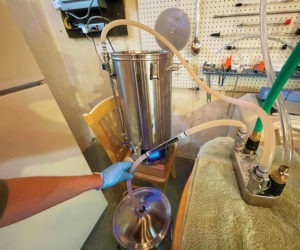Build an Electric Heat Stick
I’ve been an apartment brewer since 1987, so space has always been a problem. Then, in 2005, I purchased a 15-gallon (57-L) stainless steel conical fermenter and a 60-qt. (57-L) stainless steel brew kettle. With these two major upgrades came the inevitable step-up to brewing 10-gallon (38-L) batches. This increase created a number of problems, the first of which was heat: How was I going to boil 10 gallons (38 L) of wort in my small condo?
After surfing the Net for countless hours I came upon the solution: I saw an old “Bruheat” electric boiler on an English homebrewer’s website and thought, “that’s perfect, I could use an electric hot water heating element!” I did not want to permanently install a heating element into my kettle, however. Ideally, I wanted the heater to be portable, so I could apply heat where and when I needed it. The trick would be making something as safe as possible — electricity and water is a VERY DANGEROUS combination!
I decided to make it similar to a power tool; one with a straight handle, a short power cord, and a heating element on the other end – a “heatstick!” After seeing all my parts options, I settled on the configuration I am still using today: a hot water tank heating element attached to a kitchen sink drain pipe that’s attached to a plastic handle, with a power cord running through the middle. The hot water heating element electrical contacts are sealed water-tight from the inside with epoxy. Finally, by using a GFCI (Ground Fault Circuit Interrupter) protected wall outlet and a solid ground connection, I would have two layers of protection and be as safe from electrocution as possible if the heatstick were to develop a leak.
The primary thing I’ve learned from building this heat stick project is that the key to success is achieving a good seal around the electrical contacts of the heating element. To do that, I encapsulate or “pot” the electrical contacts in epoxy from inside the drain pipe. The heat sticks that I have now are all sealed with JB Weld epoxy, which has worked the best out of all the sealants I’ve tried, including: aquarium silicone, Alumalite casting resin and high-temp automotive RTV silicone gasket maker. JB Weld can withstand temperatures up to 450 °F (232 °C) and the epoxy never comes in contact with liquid so the heat stick is as food-safe as you can make it.
Parts and Tools
- GFCI (Ground Fault Circuit Interrupter) adapter or GFCI protected wall outlet
- Screw-in hot water heating element. (Choose based upon your home’s electrical system and how much liquid you intend to heat. For this stick, I bought a 1500 watt, 120 volt, ultra-low-density element made by Camco. Part number 02853.)
- 12-gauge, 3-wire, rubber electrical cord
- Heavy-duty, armored, 20-amp, three-prong plug
- 12-inch x 11⁄2-inch I.D. chrome plated, brass drain pipe
- 11⁄2-inch x 11⁄4-inch slip joint nut
- 6-inch x 11⁄2-inch I. D. plastic drain pipe extension tube with compression fitting nut and gasket
- 3⁄4-inch PVC coupler
- 1-inch PVC end cap
- Small brass bolt, nut and washer for ground connection
- J-B Weld epoxy (not the fast curing type)


